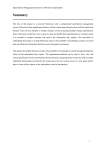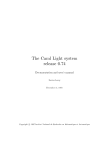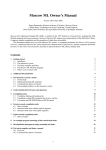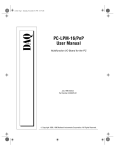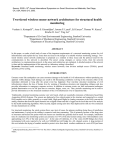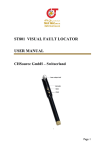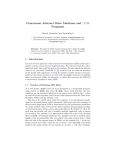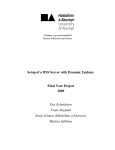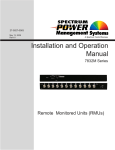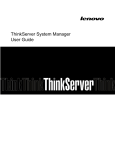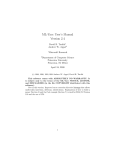Download SLB User Manual
Transcript
SLB User Manual
version 1.0, 26 April 2011
Sergey Poznyakoff.
c 2011 Sergey Poznyakoff
Copyright Permission is granted to copy, distribute and/or modify this document under the terms of the GNU Free Documentation License, Version 1.3 or any
later version published by the Free Software Foundation; with no Invariant
Sections, with the Front-Cover texts being “SLB User Manual”, and with
the Back-Cover Texts as in (a) below. A copy of the license is included in
the section entitled “GNU Free Documentation License”.
(a) The Back-Cover Text is: “You have freedom to copy and modify this
manual, like Free Software.”
i
Short Contents
1 Introduction . . . . . . . . . . . . . . . . . . . . . . . . . . . . . . . . . . . . . . . . . 1
2 Overview of this Manual . . . . . . . . . . . . . . . . . . . . . . . . . . . . . . . 3
3 Tutorial . . . . . . . . . . . . . . . . . . . . . . . . . . . . . . . . . . . . . . . . . . . . . 5
4 SLB Command Line Syntax . . . . . . . . . . . . . . . . . . . . . . . . . . . . 17
5 SLB Configuration File . . . . . . . . . . . . . . . . . . . . . . . . . . . . . . . . 21
6 Exit Codes . . . . . . . . . . . . . . . . . . . . . . . . . . . . . . . . . . . . . . . . . 35
7 Signals . . . . . . . . . . . . . . . . . . . . . . . . . . . . . . . . . . . . . . . . . . . . . 37
8 How to Report a Bug . . . . . . . . . . . . . . . . . . . . . . . . . . . . . . . . . 39
A GNU Free Documentation License . . . . . . . . . . . . . . . . . . . . . . . 41
Concept Index . . . . . . . . . . . . . . . . . . . . . . . . . . . . . . . . . . . . . . . . . . 49
iii
Table of Contents
1
Introduction . . . . . . . . . . . . . . . . . . . . . . . . . . . . . . . . . . . . . 1
2
Overview of this Manual . . . . . . . . . . . . . . . . . . . . . . . 3
3
Tutorial . . . . . . . . . . . . . . . . . . . . . . . . . . . . . . . . . . . . . . . . . . 5
3.1
3.2
3.3
3.4
3.5
3.6
3.7
3.8
3.9
4
SLB Command Line Syntax . . . . . . . . . . . . . . . . . . 17
4.1
4.2
4.3
4.4
4.5
4.6
5
Option Basics . . . . . . . . . . . . . . . . . . . . . . . . . . . . . . . . . . . . . . . . . . . . . . . . . . 5
Configuration Basics . . . . . . . . . . . . . . . . . . . . . . . . . . . . . . . . . . . . . . . . . . . 5
Daemon Configuration . . . . . . . . . . . . . . . . . . . . . . . . . . . . . . . . . . . . . . . . . 7
SNMP Configuration . . . . . . . . . . . . . . . . . . . . . . . . . . . . . . . . . . . . . . . . . . . 7
Server Definition . . . . . . . . . . . . . . . . . . . . . . . . . . . . . . . . . . . . . . . . . . . . . . . 8
Named Expressions . . . . . . . . . . . . . . . . . . . . . . . . . . . . . . . . . . . . . . . . . . . . 9
Preprocessing with m4 . . . . . . . . . . . . . . . . . . . . . . . . . . . . . . . . . . . . . . . . 10
Output . . . . . . . . . . . . . . . . . . . . . . . . . . . . . . . . . . . . . . . . . . . . . . . . . . . . . . . 12
Test Mode . . . . . . . . . . . . . . . . . . . . . . . . . . . . . . . . . . . . . . . . . . . . . . . . . . . . 14
Program Mode Options . . . . . . . . . . . . . . . . . . . . . . . . . . . . . . . . . . . . . . .
Modifier Options . . . . . . . . . . . . . . . . . . . . . . . . . . . . . . . . . . . . . . . . . . . . . .
Logging Control Options . . . . . . . . . . . . . . . . . . . . . . . . . . . . . . . . . . . . . .
Preprocessor Control Options . . . . . . . . . . . . . . . . . . . . . . . . . . . . . . . . .
Debugging Options. . . . . . . . . . . . . . . . . . . . . . . . . . . . . . . . . . . . . . . . . . . .
Informational Options . . . . . . . . . . . . . . . . . . . . . . . . . . . . . . . . . . . . . . . . .
SLB Configuration File . . . . . . . . . . . . . . . . . . . . . . . 21
5.1
Configuration file syntax . . . . . . . . . . . . . . . . . . . . . . . . . . . . . . . . . . . . . .
5.1.1 Comments . . . . . . . . . . . . . . . . . . . . . . . . . . . . . . . . . . . . . . . . . . . . . . .
5.1.2 Pragmatic Comments . . . . . . . . . . . . . . . . . . . . . . . . . . . . . . . . . . . .
5.1.3 Statements . . . . . . . . . . . . . . . . . . . . . . . . . . . . . . . . . . . . . . . . . . . . . . .
5.1.4 Preprocessor . . . . . . . . . . . . . . . . . . . . . . . . . . . . . . . . . . . . . . . . . . . . .
5.2 Syslog Configuration Directives . . . . . . . . . . . . . . . . . . . . . . . . . . . . . . . .
5.3 Daemon Configuration . . . . . . . . . . . . . . . . . . . . . . . . . . . . . . . . . . . . . . . .
5.4 Expression . . . . . . . . . . . . . . . . . . . . . . . . . . . . . . . . . . . . . . . . . . . . . . . . . . . .
5.4.1 Comparisons . . . . . . . . . . . . . . . . . . . . . . . . . . . . . . . . . . . . . . . . . . . . .
5.4.2 Function calls . . . . . . . . . . . . . . . . . . . . . . . . . . . . . . . . . . . . . . . . . . . .
5.5 SNMP Configuration . . . . . . . . . . . . . . . . . . . . . . . . . . . . . . . . . . . . . . . . . .
5.6 Server Configuration . . . . . . . . . . . . . . . . . . . . . . . . . . . . . . . . . . . . . . . . . .
5.7 Output Configuration . . . . . . . . . . . . . . . . . . . . . . . . . . . . . . . . . . . . . . . . .
5.7.1 Output Format String . . . . . . . . . . . . . . . . . . . . . . . . . . . . . . . . . . . .
6
17
18
18
18
19
19
21
21
21
22
24
25
26
26
27
28
30
30
32
32
Exit Codes . . . . . . . . . . . . . . . . . . . . . . . . . . . . . . . . . . . . . 35
iv
SLB User Manual
7
Signals . . . . . . . . . . . . . . . . . . . . . . . . . . . . . . . . . . . . . . . . . . 37
8
How to Report a Bug . . . . . . . . . . . . . . . . . . . . . . . . . 39
Appendix A GNU Free Documentation License
. . . . . . . . . . . . . . . . . . . . . . . . . . . . . . . . . . . . . . . . . . . . . . . . 41
A.1
ADDENDUM: How to use this License for your documents . . . . 48
Concept Index . . . . . . . . . . . . . . . . . . . . . . . . . . . . . . . . . . . . . 49
Chapter 1: Introduction
1
1 Introduction
It is a common practice to set up several servers for handling the same task.
In such configurations, it is important to distribute the load equally among
the computers forming the set. While the term load may refer in this context
to various things (e.g. CPU load, network traffic, etc.), the main principle
of load balancing remains the same: determine which servers are less loaded
and transfer to them part of the work from the most loaded ones.
SLB (or Simple Load Balancer) is a tool designed for handling this task.
It monitors a set of servers and uses SNMP protocol to periodically collect
a set of parameters from each of them. Once obtained, these parameters are
used as arguments to a load estimation function, which computes, for each
server, a floating point value representing its relative load. SLB then sorts
servers in the order of increasing relative load.
SLB does not attempt to actually correct load distribution, as this task
depends heavily on the kind of work the servers are performing and it is
difficult, if not impossible, to provide a generalized solution for that. Instead,
SLB relies on an external program which is supposed to redistribute the load,
based on the data obtained from SLB. Therefore, after obtaining the sorted
list of servers, SLB filters it through a user-defined format template, and
sends the result to a file, a named pipe or another program.
All parameters used by SLB, including load estimation function, are supplied to it in a configuration file, which makes the package extremely flexible.
When speaking about the package as a whole, we spell its name as SLB.
When speaking about the program which constitutes the principal part of
the package, we refer to it as slb.
Chapter 2: Overview of this Manual
3
2 Overview of this Manual
This book consists of the three main parts. The first part is a tutorial,
which provides a gentle (as far as possible) introduction for those who are
new to slb. Although it is meant to be self-contained, the reader is required
to have some basic notions about SNMP and UNIX system administration.
The tutorial should help the reader to familiarize himself with the package
and to start using it. It does not, however, cover some of the less frequently
used features of slb.
The two chapters that follow complement the tutorial. The Invocation
summarizes the command line syntax and options available to slb. The
Configuration contains a detailed reference to the configuration file syntax
and statements. These two chapters provide all the information necessary
to understand and configure slb, for both beginners and for users familiar
with the package.
Chapter 3: Tutorial
5
3 Tutorial
This chapter guides you through the most important features of slb and
explains its configuration. Start here if you have never used slb before.
It omits some complicated details and rarely used features, which will be
discussed further, in Chapter 5 [Configuration], page 21.
3.1 Option Basics
Options start with a dash. Most of them have two forms, called short and
long forms. Both forms are absolutely identical in function; they are interchangeable.
The short form is a traditional form for UNIX utilities. In this form, the
option consists of a single dash, followed by a single letter, e.g. ‘-c’.
Short options which require arguments take their arguments immediately
following the option letter, optionally separated by white space. For example, you might write ‘-o name’, or ‘-oname’. Here, ‘-o’ is the option, and
‘name’ is its argument.
Short options’ letters may be clumped together, but you are not required
to do this. When short options are clumped as a set, use one (single) dash
for them all, e.g. ‘-ne’ is equivalent to ‘-n -e’. However, only options
that do not take arguments may be clustered this way. If an option takes
an argument, it can only be the last option in such a cluster, otherwise it
would be impossible to specify the argument for it. Anyway, it is much more
readable to specify such options separated.
The long options consist of two dashes, followed by a multi-letter option name, which is usually selected to be a mnemonics for the operation
it requests. Long option names can be abbreviated, provided that such an
abbreviation is unique among the options understood by the program.
Arguments to long options follow the option name being separated from
it either by an equal sign, or by any amount of white space characters. For
example, the option ‘--eval’ with the argument ‘test’ can be written either
as ‘--eval=test’ or as ‘--eval test’.
3.2 Configuration Basics
The configuration file defines most parameters needed for the normal operation of slb. The program will not start if its configuration file does not
exist, cannot be read, or contains some errors.
The configuration file is located in your system configuration directory
(normally ‘/etc’) and is named ‘slb.conf’. You can place it elsewhere as
well, but in this case you will need to explicitly inform slb about its actual
location, using the ‘--config-file’ (‘-c’) command line option:
slb --config-file ./new.conf
6
SLB User Manual
Before actually starting the program, it is wise to check the configuration
file for errors. To do so, use the ‘--lint’ (‘-t’) command line option:
slb --lint
When started with this option, slb parses the configuration, reports any
errors on the standard error and exits. If parsing succeeds, it exits with
code 0. Otherwise, if any errors have been found, it exits with code 78
(configuration error).
The ‘--lint’ option can, of course, be used together with
‘--config-file’, e.g.:
slb --lint --config-file ./new.conf
If you are unsure about the correct configuration syntax, you can obtain
a concise summary any time, by running:
slb --config-help
The summary is printed to the standard output and includes all configuration statements with short descriptions of their purpose and arguments.
In this section we will provide a quick start introduction to the slb configuration. For a more detailed and formal discussion, refer to Chapter 5
[Configuration], page 21.
The configuration file consists of statements. There are two kinds of
statements, called simple and block statements. A simple statement consists
of a keyword and value, or values, separated by any amount of whitespace
and terminated with a semicolon, for example:
wakeup 15;
A block statement is used for logical grouping of other statements. It
consists of a keyword, optionally followed by a value, and a set of other
statements, enclosed in a pair of curly brackets. For example:
syslog {
facility local1;
tag slb;
}
A semicolon may follow the closing ‘}’, although this is not required.
Note that whitespace (i.e. space characters, tabs and newlines) has no
special syntactical meaning, except that it serves to separate otherwise adjacent tokens. For example, the following form of the ‘syslog’ statement is
entirely equivalent to the one shown above:
syslog { facility local1;
tag slb; }
Several types of comments are supported. A single-line comment starts
with ‘#’ or ‘//’ and continues to the end of the line. A multi-line or C-style
comment starts with the two characters ‘/*’ (slash, star) and continues until
the first occurrence of ‘*/’ (star, slash). Whatever comment type are used,
they are removed from the configuration prior to parsing it.
Chapter 3: Tutorial
7
After comment removal, the configuration is preprocessed using m4. This
is a highly useful feature, which allows for considerable simplification of
configuration files. It is described in Section 3.7 [m4], page 10.
3.3 Daemon Configuration
The most important daemon parameters are the operation mode and wakeup
interval. You are not required to explicitly configure them, but you may want
to do so, if their default values don’t suit you.
There are two operation modes: ‘standalone’ and ‘cron’. In standalone
mode, slb detaches itself from the controlling terminal and continues operation in the background, as a daemon. It will periodically wake up, poll the
servers, compute load table and format it to the output file or pipe. This is
the default operation mode.
In cron mode, slb starts, polls the servers, computes and formats load
table and exits when done. This mode is designed for use from crontabs,
hence its name. It has some limitation, compared to the standalone mode.
Most notably, the d() function (derivative) is not available in this mode.
If you wish to explicitly set the operation mode, use the ‘standalone’
configuration statement. The statement:
standalone yes;
configures the standalone mode, whereas the statement:
standalone no;
configures cron mode. The later can also be requested from the command
line, using the ‘--cron’ option.
When operating in standalone mode, the wakeup interval specifies the
amount of time, in seconds, between successive polls. The default value is
5 minutes. To set another value, use the ‘wakeup’ statement. For example,
the following configures slb to do a poll each minute:
wakeup 60;
3.4 SNMP Configuration
Normally, this does not require additional configuration, unless you want to
load some custom MIBs.
To load an additional MIB file, use the ‘add-mib’ statement. Its argument
is the name of the file to load.
add-mib "MY-MIBS.txt";
Unless full pathname is specified, the file is searched in the SNMP
search path. To modify the search path, use the ‘mib-directory’. Each
‘mib-directory’ adds a single directory to the end of the path:
mib-directory "/usr/share/slb/mibs";
8
SLB User Manual
3.5 Server Definition
Server definitions are principal part of any slb configurations. They define
remote servers for which slb is to compute the load table. A server definition
is a block statement which begins as:
server id {
The id argument specifies server ID, an arbitrary string of characters
uniquely identifying this server. This ID will be used by log messages concerning this server. It can also be referred to in the output format definition
(see Section 5.7 [output], page 32).
As usual, the definition ends with a closing ‘}’.
Statements inside the ‘server’ block supply configuration parameters for
this server. Two parameters are mandatory for each server: its IP address
and SNMP community:
host ip;
community string;
The ip argument can be either the IP address of the server in dotted-quad
notation, or its host name. For example:
host 192.168.10.6;
community "public";
The most important part of a server definition is its load estimation function. It is basically an arithmetic expression of arbitrary complexity, with
SNMP variables serving as its terms (see Section 5.4 [expression], page 26).
It is defined using the ‘expression’ statement.
To begin with, suppose you want to use 1-minute load average as relative
load. Let’s name it ‘la1’. Then, the expression is very simple and can be
defined as:
expression "la1";
Now, ‘la1’ is a variable name, which should be bound to the corresponding SNMP variable. This binding is declared with the ‘variable’ statement:
variable la1 "UCD-SNMP-MIB::laLoadFloat.1";
The ‘variable’ statement has two arguments. The first one is the name
of a variable used in the expression and the second one is the SNMP OID
which is bound to this variable. This OID is added to the list of OIDs
queried during each poll of this server. When a SNMP reply is received, all
instances of that variable in the expression are replaced with the value of the
corresponding SNMP variable. Once all variables have been thus resolved,
the expression is evaluated and its result is taken as the relative load for the
given server.
Let’s take a more complex example. Suppose you define the relative load
to be a function of outgoing data transfer rate through the main network
interface and the load average of the server. Data transfer rate is defined as
first derivative of data transfer through the interface with respect to time.
Let ‘out’ be the outgoing data transfer, ‘la1’ be the server’s 1-minute load
Chapter 3: Tutorial
9
average, ‘k’ and ‘m’ be two server-dependent constants (weight coefficients).
Given that, we define relative load as
expression "sqrt(k * d(out)**2 + m * la1**2)";
The ‘**’ operator raises its left operand to the power given by its second
operand. The two constructs ‘d(...)’ and ‘sqrt(...)’ are function calls.
The ‘d()’ function computes first derivative of its argument with respect to
time. The ‘sqrt()’ function computes the square root of its argument.
Now, let’s define variable bindings:
variable out "IF-MIB::ifOutOctets.3";
variable la1 "UCD-SNMP-MIB::laLoadFloat.1";
The constants ‘k’ and ‘m’ are defined using the following statements:
constant k 1.5;
constant m 1.8;
The ‘constant’ statement is similar to ‘variable’, except that its second
argument must be a floating-point number. Of course, in this particular
example, the two constants could have been placed directly in the expression
text, as in:
expression "sqrt(1.5 * d(out)**2 + 1.8 * la1**2)";
However, defining them on a per-server basis is useful when the same
expression is used for several different servers, as explained in the following
section.
To conclude, here is our sample server definition:
server srv01 {
host 192.168.10.6;
community "public";
expression "sqrt(k * d(out)**2 + m * la1**2)";
variable out "IF-MIB::ifOutOctets.3";
variable la1 "UCD-SNMP-MIB::laLoadFloat.1";
constant k 1.5;
constant m 1.8;
}
3.6 Named Expressions
In most cases, load estimation function is common for all servers (perhaps
with server-dependent set of coefficients and/or variable bindings). To simplify configuration, such a common function can be defined once and then
used by another ‘server’ definitions. It is defined as a named expression,
i.e. an expression that can be referred to by its name.
Named expressions are defined using the ‘expression’ statement outside
of ‘server’ block. Such statements take two arguments: the name of the
expression and its definition, e.g.:
expression load "sqrt(k * d(out)**2 + m * la1**2)";
10
SLB User Manual
Named expressions can be invoked from another expressions using the
‘@’ operator, followed by expression’s name. For example, the following
statement in ‘server’ block:
expression "@load";
is in fact equivalent to the expression defined above. The ‘@’ construct can,
of course, also be used as a term in arithmetic calculations, e.g.:
expression "2 * @load + 1";
A default expression is a named expression which is implicitly applied for
‘server’ statements that lack ‘expression’ statement. Default expression
is defined using the ‘default-expression’ statement:
default-expression "load";
To finish this section, here is an example configuration declaring two
servers which use the same default expression, but supply different sets of
coefficients:
expression load "sqrt(k * d(out)**2 + m * la1**2)";
default-expression "load";
server srv01 {
host 192.168.10.6;
community "public";
variable out "IF-MIB::ifOutOctets.3";
variable la1 "UCD-SNMP-MIB::laLoadFloat.1";
constant k 1.5;
constant m 1.8;
}
server srv02 {
host 192.168.10.1;
community "private";
variable out "IF-MIB::ifOutOctets.3";
variable la1 "UCD-SNMP-MIB::laLoadFloat.1";
constant k 2.5;
constant m 2.2;
}
3.7 Preprocessing with m4
In the previous section we have seen how to define two servers which use the
same expression to compute relative load. In real configurations, the number
of servers is likely to be considerably greater than that, and adding each of
them to the configuration soon becomes a tedious and error-prone task. This
task is greatly simplified by the use of preprocessor. As mentioned earlier,
the configuration file is preprocessed using m4, a traditional UNIX macro
processor. It provides a powerful framework for implementing complex slb
configurations.
Chapter 3: Tutorial
11
For example, note that in our sample configuration the ‘server’ statements differ by only three values: the server ID, its IP and community.
Taking this into account, we may define the following m4 macro:
m4_define(‘defsrv’,‘server $1 {
host $2;
community "m4_ifelse(‘$3’,,‘public’,‘$3’)";
variable out "IF-MIB::ifOutOctets.3";
variable la1 "UCD-SNMP-MIB::laLoadFloat.1";
constant k 2.5;
constant m 2.2;
}’)
The ‘defsrv’ macro takes two mandatory and one optional argument.
Mandatory arguments are the server ID and its IP address. Optional argument is SNMP community; if it is absent, the default community ‘public’
is used.
Notice, that we use m4_define, instead of the familiar define. It is
because the default slb setup renames all m4 built-in macro names so they
all start with the prefix ‘m4_’. This avoids possible name clashes and makes
preprocessor statements clearly visible in the configuration.
Using this new macro, the above configuration is reduced to the following
two lines:
defsrv(srv01, 192.168.10.6)
defsrv(srv02, 192.168.10.1, private)
Declaring a new server is now a matter of adding a single line of text.
The default preprocessor setup defines a set of useful macros, among them
m4_foreach (see Section “foreach” in GNU M4 macro processor). This
macro can be used to further simplify the configuration, as shown in the
example below:
m4_foreach(args,
‘‘srv01, 192.168.10.6’,
‘srv02, 192.168.10.1, private’,
‘srv03, 192.168.0.3’,
‘srv04, 192.168.100.1, foo’,
‘srv05, 192.168.100.2, bar’’,
‘defserv(args)
’)
The second argument to m4_foreach is a comma-separated list of values.
The expansion is as follows: for each value from this list, the value is assigned
to the first argument (‘args’). Then the third argument is expanded and
the result is appended to the overall expansion.
In this particular example, each line produces an expansion of the
‘defserv’ macro with the arguments taken from that line. Note, that each
argument in the list must be quoted, because it contains commas. Note also
12
SLB User Manual
the use of the optional third arguments to supply community names that
differ from the default one.
For a detailed information about slb preprocessor feature, see
Section 5.1.4 [Preprocessor], page 24.
3.8 Output
When slb has finished building load table, it sends it to the output, line
by line, using the output format string. This format string is similar to the
format argument of printf(1): any characters, except ‘%’ are copied to the
output verbatim; the ‘%’ introduces a conversion specifier. For example, ‘%i’
expands to the ID of the server this line refers to. The ‘%w’ specifier expands
to the computed relative load for that server, etc. There is a number of such
specifiers, they are all described in detail in Section 5.7.1 [output format],
page 32.
The default output format is ‘%i %w\n’. This produces a table, each line
of which shows a server ID and its relative load. This default is suitable
for testing purposes, but for real configurations you will most probably need
to create a custom output format. You do so using the ‘output-format’
statement:
output-format "id=%i host=%h\n";
The output format string can be quite complex as shown in the following
example:
output-format <<EOT
server 10.0.0.1
update add www.example.net 60 IN A %h
send
EOT;
This format creates, for each line from the load table, a set of commands
for nsupdate1 . The ‘<<’ block introduces a here-document, a construct similar to that of shell and several other programming languages. It is discussed
in [here-document], page 23.
You may need to include server-dependent data in the corresponding output lines. For this purpose, slb provides server macros. Server macros are
special text variables, defined in the ‘server’ block, which can be accessed
from output format string.
Macros are defined using the ‘macro’ statement, whose syntax is similar
to that of ‘variable’ or ‘constant’. The first argument supplies the name
of the macro, and the second one, its contents, or expansion, e.g.:
server srv01 {
host 192.168.10.6;
community "public";
macro description "some descriptive text";
1
See Section “Dynamic DNS update utility” in nsupdate(8) man page.
Chapter 3: Tutorial
13
}
Macros are accessed using the following conversion specifier:
%(name)
where name is the name of the macro. This specifier is replaced with the
actual contents of the macro. The following example uses the ‘description’
macro to create a TXT record in the DNS:
output-format <<EOT
server 10.0.0.1
update add www.example.net 60 IN A %h
update add %i.example.net 60 IN TXT "%(description)"
send
EOT;
Sometimes you may need to produce some output immediately before
the load table or after it. Two configuration statements are provided
for that purpose: ‘begin-output-message’ and ‘end-output-message’.
Both take a single string as argument.
The string supplied with
‘begin-output-message’ is output before formatting the load table, and
the one supplied with ‘end-output-message’ is output after formatting it.
Continuing our ‘nsupdate’ example, the following statement will remove
all existing A records from the DNS prior to creating new ones:
begin-output-message <<EOT
server 10.0.0.1
update delete www.example.net
send
EOT;
You may want to output only a part of the load table. Two statements
are provided for this purpose. The ‘head N’ statement outputs at most N
entries from the top of the table. The ‘tail N’ statement outputs at most N
entries from the bottom of the table. For example, to print only one entry
corresponding to the least loaded server, use
head 1;
By default slb prints results to the standard output. To change this, use
the ‘output-file’ statement. Its argument specifies the name of a file where
slb output will be directed. If this name starts with a pipe character (‘|’),
slb treats the remaining characters as the shell command. This command is
executed (using /bin/sh -c), and the output is piped to its standard input.
Thus, the following statement
output-file "| /usr/bin/nsupdate "
"-k /usr/share/slb/Kvpn.+157+45756.private";
directs the formatted output to the standard input of nsupdate command.
14
SLB User Manual
3.9 Test Mode
The slb configuration can be quite complex, therefore it is important to verify that it behaves as expected before actually implementing it in production.
Three command line options are provided for that purpose.
The ‘--dry-run’ (or ‘-n’) option instructs the program to start in foreground mode and print to the standard output what would have otherwise
been printed to the output file. Additional debugging information is displayed on the standard error.
The ‘--eval’ option initiates expression evaluation mode. In this mode
slb evaluates the expression whose name is supplied as argument to the
option. Actual values of the variables and constants used in the expression
are supplied in the command line in form of variable assignments. The
result is printed to the standard output. For example, if the configuration
file contains
expression load "(la1/100 + usr/1024)/2";
then the command
slb --eval=load la1=30 usr=800
will print ‘.540625’.
If the expression contains calls to ‘d()’ (derivative), you will need several
evaluations to compute its value. The minimal number of evaluations equals
the order of the highest derivative computed by the expression, plus 1. Thus,
computing the following expression:
expression load "sqrt(k * d(out)**2 + m * la1**2)";
requires at least two evaluations. To supply several values to a single variable, separate them with commas, e.g.: ‘out=16000,20000’. This will run
first evaluation with ‘out=16000’ and the second one with ‘out=20000’. For
example:
$ slb --eval=load k=1.5 m=3 out=16000,20000 la1=0.4
16.3446
Notice, that you don’t need to supply the same number of values for each
variable. If a variable is assigned a single value, this value will be used in all
evaluations.
A more elaborate test facility is enabled by the ‘--test’ option. This
option instructs slb to read SNMP variables and their values from a file
and act as if they were returned by SNMP. The output is directed to the
standard output, unless the ‘--output-file’ option is also given.
The input file name is taken from the first non-option argument. If it is
‘-’ (a dash) or if no arguments are given, the standard input will be read:
slb --test input.slb
The input file consists of sections separated by exactly one empty line.
A section contains assignments to SNMP variables in the style of snmpset2 .
2
See Section “snmpset” in snmpset(1) man page.
Chapter 3: Tutorial
15
Such assignments form several server groups, each group being preceded by
a single word on a line, followed by a semicolon. This word indicates the ID
of the server to which the data in the group belong. For example:
srv01:
UCD-SNMP-MIB::laLoadFloat.1 F 0.080000
IF-MIB::ifOutUcastPkts.3 c 346120120
srv02:
UCD-SNMP-MIB::laLoadFloat.1 F 0.020000
IF-MIB::ifOutUcastPkts.3 c 2357911693
This section supplies data for two servers, named ‘srv01’ and ‘srv02’.
Chapter 4: SLB Command Line Syntax
17
4 SLB Command Line Syntax
The format of slb invocation is:
slb options args
where options are command line options and args are non-optional arguments.
Non-optional arguments are allowed only if either ‘--test’ or ‘--eval’
option is used in options.
4.1 Program Mode Options
‘--config-file=file’
‘-c file’ Use file instead of the default configuration file.
‘--cron’
Start in cron mode. Normally slb operates in daemon mode,
in which it polls the monitored servers at fixed intervals and
outputs the resulting load table. In contrast, when in cron mode,
slb performs a single poll, outputs the table and exits. This
mode is useful when starting slb from cron, hence its name.
Notice that the function ‘d’ (derivative, see [derivative], page 29)
does not work in this mode.
‘--dry-run’
‘-n’
Run in foreground mode and print to the standard output what
would have otherwise been printed to the output file. This
option implies ‘--stderr --debug snmp.1 --debug output.1’.
Use additional ‘--debug’ options to get even more info.
The ‘pidfile’ configuration statement is ignored in dry run
mode (see [pidfile], page 26).
‘--eval=name’
Evaluate the named expression name, print its result and exit.
Arguments for the expression can be supplied in the form of
assignments in the command line, e.g.:
slb --eval=loadavg la1=10 x=18
See Section 3.9 [Test Mode], page 14, for a detailed discussion
of the expression evaluation mode.
‘--test’
Test mode. Instead of polling servers via SNMP, slb reads
data from the file given as the first non-option argument on the
command line (or from the standard input, if no arguments are
given). The output is directed to the standard output, unless
the ‘--output-file’ option is also given.
See Section 3.9 [Test Mode], page 14, for a detailed information
about the test mode, including a description of the input format.
Example usage:
18
SLB User Manual
slb --test input.slb
‘-E’
‘--lint’
‘-t’
Show preprocessed configuration and exit.
Parse configuration file, report any errors on the standard error
and exit with code 0, if the syntax is OK, and with code 1
otherwise.
4.2 Modifier Options
‘--foreground’
Remain in the foreground. Useful for debugging purposes. See
[foreground statement], page 26.
‘--output-file=file’
‘-o file’ Direct output to file. This option overrides the ‘output-file’
setting in the configuration file. See [output-file], page 32, for a
discussion of file syntax.
4.3 Logging Control Options
‘--stderr’
‘-e’
Log to the standard error.
‘--syslog’
Log all diagnostics to syslog.
4.4 Preprocessor Control Options
‘--define=name[=value]’
‘-Dname[=value]’
Define the preprocessor symbol name as having value, or empty.
See Section 5.1.4 [Preprocessor], page 24.
‘--include-directory=dir’
‘-I dir’
Add dir to include search path.
See Section 5.1.2 [Pragmatic Comments], page 21.
‘--no-preprocessor’
Disable preprocessor. see Section 5.1.4 [Preprocessor], page 24.
‘--preprocessor=command’
Use command instead of the default preprocessor.
Section 5.1.4 [Preprocessor], page 24.
see
Chapter 4: SLB Command Line Syntax
19
4.5 Debugging Options
‘--debug=cat[.level]’
‘-d cat[.level]’
Sets debugging level for the category cat.
Category is a string that designates a part of the program from which
the additional debugging information is requested. See below for a list of
available categories.
Level is a decimal number between 0 and 100 which indicates how much
additional information is required. The level of 0 means ‘no information’
and effectively disables the category in question. The level of 100 means
maximum amount of information available. If level is omitted, 100 is assumed.
The following table lists categories available in version 1.0:
main
Main program block.
eval
Expression evaluation.
egram
Expression grammar and parser.
elex
Expression lexical analyzer.
snmp
SNMP request-reply loop.
output
Output driver.
cfgram
Configuration file grammar.
cflex
Configuration file lexer.
4.6 Informational Options
‘--config-help’
Show configuration syntax summary.
‘--help’
‘-h’
Print a concise usage summary and exit.
‘--usage’
Print a summary of command line syntax and exit.
‘--version’
‘-v’
Print the program version and exit.
Chapter 5: SLB Configuration File
21
5 SLB Configuration File
Upon startup, slb reads its settings from the configuration file
‘slb.conf’. This file is normally located in $sysconfidr (i.e., in most cases
‘/usr/local/etc’, or ‘/etc’), but an alternative location can be specified
using the ‘--config’ command line option (see Section 3.2 [Configuration
Basics], page 5).
If any errors are encountered in the configuration file, the program reports
them on its error output and exits with a non-zero status.
To test the configuration file without starting the server use the ‘--lint’
(‘-t’) command line option. It instructs the program to check configuration
file for syntax errors and other inconsistencies and to exit with status 0 if
no errors were detected, and with status 1 otherwise.
Before parsing, the configuration file is preprocessed using m4 (see
Section 5.1.4 [Preprocessor], page 24). To see the preprocessed configuration
without actually parsing it, use the ‘-E’ command line option. To disable
preprocessing, use the ‘--no-preprocessor’ option.
The rest of this section describes the configuration file syntax in detail.
You can receive a concise summary of all configuration directives any time
by running slb --config-help.
5.1 Configuration file syntax
The configuration file consists of statements and comments.
There are three classes of lexical tokens: keywords, values, and separators.
Blanks, tabs, newlines and comments, collectively called white space are
ignored except as they serve to separate tokens. Some white space is required
to separate otherwise adjacent keywords and values.
5.1.1 Comments
Comments may appear anywhere where white space may appear in the configuration file. There are two kinds of comments: single-line and multi-line
comments. Single-line comments start with ‘#’ or ‘//’ and continue to the
end of the line:
# This is a comment
// This too is a comment
Multi-line or C-style comments start with the two characters ‘/*’ (slash,
star) and continue until the first occurrence of ‘*/’ (star, slash).
Multi-line comments cannot be nested. However, single-line comments
may well appear within multi-line ones.
5.1.2 Pragmatic Comments
Pragmatic comments are similar to usual single-line comments, except that
they cause some changes in the way the configuration is parsed. Pragmatic
22
SLB User Manual
comments begin with a ‘#’ sign and end with the next physical newline character. The version 1.0 of slb, understands the following pragmatic comments:
#include <file>
#include file
Include the contents of the file file. If file is an absolute file
name, both forms are equivalent. Otherwise, the form with angle
brackets searches for the file in the include search path, while
the second one looks for it in the current working directory first,
and, if not found there, in the include search path.
The default include search path is:
1. ‘prefix/share/slb/1.0/include’
2. ‘prefix/share/slb/include’
where prefix is the installation prefix.
New directories can be appended in front of it using
‘-I’ (‘--include-directory’) command line option (see
Section 5.1.4 [Preprocessor], page 24).
#include_once <file>
#include_once file
Same as #include, except that, if the file has already been included, it will not be included again.
#line num
#line num "file"
This line causes slb to believe, for purposes of error diagnostics,
that the line number of the next source line is given by num and
the current input file is named by file. If the latter is absent, the
remembered file name does not change.
# num "file"
This is a special form of #line statement, understood for compatibility with the c preprocessor.
In fact, these statements provide a rudimentary preprocessing features.
For more sophisticated ways to modify configuration before parsing, see
Section 5.1.4 [Preprocessor], page 24.
5.1.3 Statements
A simple statement consists of a keyword and value separated by any amount
of whitespace. Simple statement is terminated with a semicolon (‘;’).
The following is a simple statement:
standalone yes;
pidfile /var/run/slb.pid;
A keyword begins with a letter and may contain letters, decimal digits,
underscores (‘_’) and dashes (‘-’). Examples of keywords are: ‘expression’,
‘output-file’.
Chapter 5: SLB Configuration File
23
A value can be one of the following:
number
A number is a sequence of decimal digits.
boolean
A boolean value is one of the following: ‘yes’, ‘true’, ‘t’ or ‘1’,
meaning true, and ‘no’, ‘false’, ‘nil’, ‘0’ meaning false.
unquoted string
An unquoted string may contain letters, digits, and any of the
following characters: ‘_’, ‘-’, ‘.’, ‘/’, ‘@’, ‘*’, ‘:’.
quoted string
A quoted string is any sequence of characters enclosed in doublequotes (‘"’). A backslash appearing within a quoted string introduces an escape sequence, which is replaced with a single
character according to the following rules:
Sequence
\a
\b
\f
\n
\r
\t
\v
\\
\"
Replaced with
Audible bell character (ASCII 7)
Backspace character (ASCII 8)
Form-feed character (ASCII 12)
Newline character (ASCII 10)
Carriage return character (ASCII
13)
Horizontal tabulation character
(ASCII 9)
Vertical
tabulation
character
(ASCII 11)
A single backslash (‘\’)
A double-quote.
Table 5.1: Backslash escapes
In addition, the sequence ‘\newline’ is removed from the string.
This allows to split long strings over several physical lines, e.g.:
"a long string may be\
split over several lines"
If the character following a backslash is not one of those specified
above, the backslash is ignored and a warning is issued.
Two or more adjacent quoted strings are concatenated, which
gives another way to split long strings over several lines to improve readability. The following fragment produces the same
result as the example above:
"a long string may be"
" split over several lines"
Here-document
A here-document is a special construct that allows to introduce
strings of text containing embedded newlines.
24
SLB User Manual
The <<word construct instructs the parser to read all the following lines up to the line containing only word, with possible
trailing blanks. Any lines thus read are concatenated together
into a single string. For example:
<<EOT
A multiline
string
EOT
The body of a here-document is interpreted the same way as
a double-quoted string, unless word is preceded by a backslash
(e.g. ‘<<\EOT’) or enclosed in double-quotes, in which case the
text is read as is, without interpretation of escape sequences.
If word is prefixed with - (a dash), then all leading tab characters
are stripped from input lines and the line containing word. Furthermore, if - is followed by a single space, all leading whitespace
is stripped from them. This allows to indent here-documents in
a natural fashion. For example:
<<- TEXT
The leading whitespace will be
ignored when reading these lines.
TEXT
It is important that the terminating delimiter be the only token
on its line. The only exception to this rule is allowed if a heredocument appears as the last element of a statement. In this case
a semicolon can be placed on the same line with its terminating
delimiter, as in:
help-text <<-EOT
A sample help text.
EOT;
A block statement introduces a logical group of statements. It consists
of a keyword, followed by an optional value, and a sequence of statements
enclosed in curly braces, as shown in the example below:
server srv1 {
host 10.0.0.1;
community "foo";
}
The closing curly brace may be followed by a semicolon, although this is
not required.
5.1.4 Preprocessor
Before actual parsing, the configuration file is preprocessed. The built-in preprocessor handles only file inclusion and #line statements (see Section 5.1.2
[Pragmatic Comments], page 21), while the rest of traditional preprocessing facilities, such as macro expansion, is supported via m4, which serves as
external preprocessor.
Chapter 5: SLB Configuration File
25
The detailed description of m4 facilities lies far beyond the scope of this
document. You will find a complete user manual in Section “GNU M4” in
GNU M4 macro processor. For the rest of this subsection we assume the
reader is sufficiently acquainted with m4 macro processor.
The external preprocessor is invoked with ‘-s’ flag, which instructs it to
include line synchronization information in its output. This information is
then used by the parser to display meaningful diagnostic.
An initial set of macro definitions is supplied by the ‘pp-setup’ file, located in ‘$prefix/share/slb/version/include’ directory (where version
means the version of SLB).
The default ‘pp-setup’ file renames all m4 built-in macro names so they all
start with the prefix ‘m4_’. This is similar to GNU m4 ‘--prefix-builtin’
options, but has an advantage that it works with non-GNU m4 implementations as well.
Additional control over the preprocessor is provided via the following
command line options:
‘--define=name[=value]’
‘-Dname[=value]’
Define the preprocessor symbol name as having value, or empty.
‘--include-directory=dir’
‘-Idir’
Add dir to the list of directories searched for preprocessor include files.
‘--no-preprocessor’
Disable preprocessor.
‘--preprocessor=command’
Use command instead of the default preprocessor.
5.2 Syslog Configuration Directives
When running in standalone mode slb normally uses syslog to print diagnostic messages. By default, the program uses the ‘daemon’ facility. The
syslog statement allows to change that:
syslog { ... }
[Config]
syslog {
facility local1;
tag slb;
print-priority yes;
}
facility name
[Config: syslog]
Configures the syslog facility to use. Allowed values are: ‘auth’,
‘authpriv’, ‘cron’, ‘daemon’, ‘ftp’, ‘local0’ through ‘local7’, and
‘mail’.
26
SLB User Manual
tag string
[Config: syslog]
This statement sets the syslog tag, a string identifying each message issued
by the program. By default, it is the name of the program with the
directory parts removed.
print-priority bool
[Config: syslog]
In addition to priority segregation, provided by syslog, you can instruct
slb to prefix each syslog message with its priority. To do so, set:
print-priority yes;
5.3 Daemon Configuration
The following statements configure slb activities in daemon mode.
standalone bool
[Config]
Enables or disables standalone daemon mode. The standalone mode is
enabled by default. It is disabled either by setting
standalone no;
in the configuration file, or by using the ‘--cron’ command line option
(see [option–cron], page 17).
foreground bool
[Config]
Do not detach from the controlling terminal. See [option–foreground],
page 18.
pidfile string
Store master process PID in file.
‘/var/run/slb.pid’.
[Config]
Default pidfile location is
wakeup number
[Config]
Sets wake-up interval in seconds. SLB will recompute the server load
table each number seconds.
suppress-output number
[Config]
Suppress output during the first number wakeups. This statement is
reserved mostly for debugging purposes.
5.4 Expression
The following statement creates a named expression:
expression name expr
[Config]
Define the expression name to be expr.
Named expressions can be used as load estimation functions in server
statements (see Section 5.6 [server], page 30) and invoked from the output
format string (see Section 5.7.1 [output format], page 32).
Chapter 5: SLB Configuration File
27
default-expression name
[Config]
Declares the default expression. The name refers to a named expression
declared elsewhere in the configuration file.
The default expression is used to compute relative load of servers whose
‘server’ declaration lacks explicit ‘expression’ definition (see [serverexpression], page 31).
The expr in the ‘expression’ statement is an arithmetical expression,
which evaluates to a floating point number. The expression consists of terms,
function calls and operators. The terms are floating point numbers, variable and constant names. The names refer to constants or SNMP variables
defined in the definition of the server, for which this expression is being
evaluated.
The following operations are allowed in expression:
Arithmetic operations
+
Addition
-
Subtraction
*
Multiplication
/
Division
**
Power
Named expression reference
A named expression reference is a reference to an expression defined by a
‘expression’ statement elsewhere in the configuration file. The reference
has the following syntax:
@name
where name is the name of the expression as given by the first argument of
its definition (see Section 5.4 [expression], page 26).
Ternary conditional operator
The ternary conditional operator is used to select a value based on a condition. It has the following form:
cond ? expr1 : expr2
The ternary operator evaluates to expr1 if cond yields ‘true’ (i.e. returns
a non-null value) and to expr2 otherwise.
The condition cond is an expression which, apart from the arithmetic
operators above, can use the following comparison and logical operations:
5.4.1 Comparisons
a == b
True if a equals b
28
SLB User Manual
a != b
True if the operands are not equal.
a<b
True if a is less than b.
a <= b
True if a is less than or equal to b.
a>b
True if a is greater than b.
a >= b
True if a is greater than or equal to b.
Logical operations
!expr
True if expr is false.
a && b
Logical and: true if both a and b are true, false otherwise.
a || b
Logical or: true if at least one of a or b are true.
Both logical ‘and’ and ‘or’ implement boolean shortcut evaluation: their
second argument (b) is evaluated only when the first one is not sufficient to
compute the result.
Precedence
The following table lists all operators in order of decreasing precedence:
Operators
Description
(...)
Grouping
?
Ternary operator
**
Power (right-associative)
Unary negation
*/
Multiplication, division
+Addition, subtraction
< <= >= >
Relational operators (non-associative)
== !=
Equality comparison (non-associative)
!
Boolean negation
&&
Logical ‘and’.
||
Logical ‘or’
When operators of equal precedence are used together they are evaluated from left to right (i.e., they are left-associative), except for comparison
operators, which are non-associative and for the power operator, which is
right-associative (these are explicitly marked as such in the above table).
This means, for example that you cannot write:
(5 <= x <= 10) ? x : y
Instead, you should write:
(5 <= x && x <= 10) ? x : y
5.4.2 Function calls
Function calls have the following syntax:
Chapter 5: SLB Configuration File
29
name(arglist)
where name stands for the function name and arglist denotes the argument
list: a comma-separated list of expressions which are evaluated and supply
actual arguments for the function.
The following functions are supported by SLB version 1.0:
d (x)
[function]
Returns the derivative of x, i.e. the speed of its change per second,
measured between the two last wakeups of slb (see Section 3.3 [Daemon
Configuration], page 7).
Notice, that this function is available only in standalone mode (see
Section 3.3 [Daemon Configuration], page 7).
max (x0, ..., xn)
[function]
Returns the maximum value of its arguments. Any number of arguments
can be given.
min (x0, ..., xn)
[function]
Returns the minimum value of its arguments.
avg (x0, ..., xn)
[function]
Returns the average value of its arguments.
log (x)
[function]
Returns the natural logarithm of x.
log10 (x)
[function]
Returns the decimal logarithm of x.
exp (x)
[function]
Returns the value of e (the base of natural logarithms) raised to the power
of x.
pow (x, y)
[function]
Returns the value of x raised to the power of y. This function is provided
for the sake of completeness, as it is entirely equivalent to ‘x ** y’.
sqrt (x)
[function]
Returns the non-negative square root of x.
abs (x)
[function]
Returns the absolute value of x.
ceil (x)
Returns the smallest integral value that is not less than x.
ceil(0.5) ⇒ 1.0
ceil(-0.5) ⇒ 0
[function]
30
SLB User Manual
floor (x)
[function]
Returns the largest integral value that is not greater than x.
floor(0.5) ⇒ 0.0
floor(-0.5) ⇒ -1.0
trunc (x)
[function]
Rounds x to the nearest integer not larger in absolute value.
round (x)
[function]
Rounds x to the nearest integer, but round halfway cases away from zero:
round(0.5) ⇒ 1.0
round(-0.5) ⇒ -1.0
5.5 SNMP Configuration
mib-directory dir
[Config]
Adds dir to the list of directories searched for the MIB definition files.
add-mib file
[Config]
Reads MIB definitions from file.
5.6 Server Configuration
server id { ... }
[Config]
server id {
enable bool;
host string;
timeout number;
retries number;
community string;
expression expr;
variable name oid;
constant name value;
macro name expansion;
assert oid op pattern;
}
Creates a new entry in the database of monitored servers. The id parameter supplies the server identifier, an arbitrary string which will be used
in log messages related to that server. Its value is also available in output
format string as format specifier ‘%i’ (see Section 5.7.1 [output format],
page 32).
Other parameters of the server are defined in the substatements, as described below.
enable bool
[Config: server]
If bool is ‘no’, this server is disabled, i.e. it is not polled nor taken account
of in load calculations. Use this statement if you want to temporarily
disable a server.
Chapter 5: SLB Configuration File
host string
31
[Config: server]
Sets the IP address (or hostname) of this server.
timeout number
[Config: server]
Sets the timeout for SNMP requests to that server.
retries number
[Config: server]
Sets the maximum number of retries for that server, after which a timeout
is reported.
community string
[Config: server]
Sets SNMP community.
expression string
[Config: server]
Defines load estimation function for this server. See Section 5.4 [expression], page 26, for a description of the syntax of string. If this statement
is absent, the default expression will be used (see [default-expression],
page 26). If it is not declared as well, an error is reported.
variable name oid
[Config: server]
Defines a variable name to have the value returned by oid. The latter
must return a numeric value.
Any occurrence of name in the expression (as defined in the ‘expression’
statement) is replaced with this value.
constant name number
[Config: server]
Defines a constant name to have the value returned by oid.
Notice that expression variables and constants share the same namespace, therefore it is an error to have both a ‘variable’ and a ‘constant’
statement defining the same name.
macro name expansion
[Config: server]
Defines a macro name to expand to expansion. Macros allow to customize
output formats on a per-server basis. See [macro], page 12.
assert oid op pattern
[Config: server]
Ensures that the value of SNMP variable oid matches pattern. The type
of match is given by the op argument:
eq
The value must match pattern exactly.
ne
The value must not match pattern.
If the assertion fails, the server is excluded from the load table.
Use this statement to ensure that a variable used in the computation
refers to a correct entity. For example, if your expression refers to
‘IF-MIB::ifInOctets.3’ (number of input octets on network interface
3), it would be wise to ensure that the 3rd row refers to the interface in
question (say ‘eth1’):
assert "IF-MIB::ifDescr.3" eq "STRING: eth1";
Notice, that pattern must include the data type.
32
SLB User Manual
5.7 Output Configuration
The statement discussed in this section configure formatting of the server
load table on output.
head number
[Config]
Print at most number entries from the top of the table, i.e. the number
of the less loaded server entries.
tail number
[Config]
Print at most number entries from the bottom of the table, i.e. the
number of the most loaded server entries.
output-file string
[Config]
Send output to the channel, identified by string. Unless string starts with
a pipe sign, it is taken as a literal name of the file. If this file does not
exist, it is created. If it exists, it is truncated. The file name can refer to
a regular file, symbolic link or named pipe.
If string starts with a ‘|’ (pipe), the rest of the string is taken as the name
of an external program and its command line arguments. The program
is started before slb enters its main loop and the formatted load table is
piped on its standard input.
begin-output-message string
[Config]
Defines the text to be output before the actual load table contents. The
string is taken literally. For example, if you want it to appear on a line
by itself, put ‘\n’ at the end of it (see Table 5.1).
end-output-message string
[Config]
Defines the text to be output after the actual load table contents. The
string is taken literally.
output-format string
[Config]
Defines format for outputting load table entries. See the subsection below
(see Section 5.7.1 [output format], page 32), for a description of available
format specifications.
5.7.1 Output Format String
The format string is composed of zero or more directives: ordinary characters (not ‘%’), which are copied unchanged to the output; and conversion
specifications, each of which is replaced with the result of a corresponding
conversion. Each conversion specification is introduced by the character ‘%’,
and ends with a conversion specifier. In between there may be (in this order) zero or more flags, an optional minimum field width and an optional
precision.
Flags
Chapter 5: SLB Configuration File
33
0
The value should be zero padded. This affects all floating-point
conversions, i.e. ‘w’ and ‘{...}’, for which the resulting value
is padded on the left with zeros rather than blanks. If the ‘0’
and ‘-’ flags both appear, the ‘0’ flag is ignored. If a precision
is given with a floating-point conversion, the ‘0’ flag is ignored.
For other conversions, the behavior is undefined.
-
The converted value is to be left adjusted on the field boundary. (The default is right justification.) Normally, the converted
value is padded on the right with blanks, rather than on the left
with blanks or zeros. A ‘-’ overrides a ‘0’ if both are given.
’ ’ (a space)
A blank should be left before a positive number (or empty string)
produced by conversion.
The field width
An optional decimal digit string (with non-zero first digit) specifying a minimum field width. If the converted value has fewer characters than the field
width, it will be padded with spaces on the left (or right, if the ‘-’ flag has
been given).
In no case does a nonexistent or small field width cause truncation of a
field; if the result of a conversion is wider than the field width, the field is
expanded to contain the conversion result.
The precision
An optional precision, in the form of a period (‘.’) followed by an optional
decimal digit string. If the precision is given as just ‘.’, or the precision
is negative, the precision is taken to be zero. This gives the number of
digits to appear after the radix character for floating-point conversions or
the maximum number of characters to be printed from a string, for string
conversions.
The conversion specifier
A character or a sequence of characters that specifies the type of conversion
to be applied. The conversion specifiers are replaced in the resulting output
string as described in the table below:
i
The server identifier.
h
The server hostname, as set by the host configuration directive.
w
Computed relative load.
{var }
The value of the variable var.
{@expr-name }
The result of evaluating expression expr-name in the context of
the current server.
34
SLB User Manual
(macro)
Expansion of the macro.
%
The percent character.
Chapter 6: Exit Codes
35
6 Exit Codes
When SLB terminates, it reports the result of its invocation in form of exit
code. Exit code of 0 indicates normal termination. Non-zero exit codes
indicate some kind of error. In this case the exact cause of failure will be
reported on the currently selected logging channel.
The exit codes are as follows:
0 (EX OK)
Normal termination.
64 (EX USAGE)
The program was invoked incorrectly.
65 (EX DATAERR)
Input data were invalid or malformed. This error code is returned only when slb is used with ‘--test’ or ‘--eval’ options
(see Section 3.9 [Test Mode], page 14).
69 (EX UNAVAILABLE)
Some error occurred. For example, the program was unable to
open output file, etc.
70 (EX SOFTWARE)
Internal software error. This usually means hitting a bug in the
program, so please report it (see Chapter 8 [Reporting Bugs],
page 39).
98 (EX CONFIG)
Program terminated due to errors in configuration file.
Chapter 7: Signals
37
7 Signals
The program handles a set of signals. To send a signal to slb use the
following command:
kill -signal ‘cat /var/run/slb.pid‘
Replace ‘/var/run/slb.pid’ with the actual pathname of the PID-file,
if it was set using the ‘pidfile’ configuration statement.
The ‘SIGHUP’ signal instructs the running instance of the program to
restart itself. It is possible only if slb was started using its full pathname.
The signals ‘SIGTERM’, ‘SIGQUIT’, and ‘SIGINT’ cause immediate termination of the program.
Chapter 8: How to Report a Bug
39
8 How to Report a Bug
Please, report bugs and suggestions to [email protected].
You hit a bug if at least one of the conditions below is met:
• slb terminates on signal 11 (SIGSEGV) or 6 (SIGABRT).
• slb terminates with exit code 70 (internal software error)
• The program fails to do its job as described in this manual.
If you think you’ve found a bug, please be sure to include maximum
information available to reliably reproduce it, or at least to analyze it. The
information needed is:
• Version of the package you are using.
• Compilation options used when configuring the package.
• Command line options used.
• Configuration file.
• Conditions under which the bug appears.
Any errors, typos or omissions found in this manual also qualify as bugs.
Please report them, if you happen to find any.
Appendix A: GNU Free Documentation License
41
Appendix A GNU Free Documentation
License
Version 1.2, November 2002
c 2000,2001,2002 Free Software Foundation, Inc.
Copyright 59 Temple Place, Suite 330, Boston, MA 02111-1307, USA
Everyone is permitted to copy and distribute verbatim copies
of this license document, but changing it is not allowed.
0. PREAMBLE
The purpose of this License is to make a manual, textbook, or other
functional and useful document free in the sense of freedom: to assure
everyone the effective freedom to copy and redistribute it, with or without modifying it, either commercially or noncommercially. Secondarily,
this License preserves for the author and publisher a way to get credit
for their work, while not being considered responsible for modifications
made by others.
This License is a kind of “copyleft”, which means that derivative works
of the document must themselves be free in the same sense. It complements the GNU General Public License, which is a copyleft license
designed for free software.
We have designed this License in order to use it for manuals for free software, because free software needs free documentation: a free program
should come with manuals providing the same freedoms that the software does. But this License is not limited to software manuals; it can
be used for any textual work, regardless of subject matter or whether it
is published as a printed book. We recommend this License principally
for works whose purpose is instruction or reference.
1. APPLICABILITY AND DEFINITIONS
This License applies to any manual or other work, in any medium,
that contains a notice placed by the copyright holder saying it can be
distributed under the terms of this License. Such a notice grants a
world-wide, royalty-free license, unlimited in duration, to use that work
under the conditions stated herein. The “Document”, below, refers to
any such manual or work. Any member of the public is a licensee, and
is addressed as “you”. You accept the license if you copy, modify or
distribute the work in a way requiring permission under copyright law.
A “Modified Version” of the Document means any work containing the
Document or a portion of it, either copied verbatim, or with modifications and/or translated into another language.
A “Secondary Section” is a named appendix or a front-matter section
of the Document that deals exclusively with the relationship of the publishers or authors of the Document to the Document’s overall subject (or
to related matters) and contains nothing that could fall directly within
42
SLB User Manual
that overall subject. (Thus, if the Document is in part a textbook of
mathematics, a Secondary Section may not explain any mathematics.)
The relationship could be a matter of historical connection with the
subject or with related matters, or of legal, commercial, philosophical,
ethical or political position regarding them.
The “Invariant Sections” are certain Secondary Sections whose titles
are designated, as being those of Invariant Sections, in the notice that
says that the Document is released under this License. If a section
does not fit the above definition of Secondary then it is not allowed to
be designated as Invariant. The Document may contain zero Invariant
Sections. If the Document does not identify any Invariant Sections then
there are none.
The “Cover Texts” are certain short passages of text that are listed, as
Front-Cover Texts or Back-Cover Texts, in the notice that says that the
Document is released under this License. A Front-Cover Text may be
at most 5 words, and a Back-Cover Text may be at most 25 words.
A “Transparent” copy of the Document means a machine-readable copy,
represented in a format whose specification is available to the general
public, that is suitable for revising the document straightforwardly with
generic text editors or (for images composed of pixels) generic paint programs or (for drawings) some widely available drawing editor, and that
is suitable for input to text formatters or for automatic translation to
a variety of formats suitable for input to text formatters. A copy made
in an otherwise Transparent file format whose markup, or absence of
markup, has been arranged to thwart or discourage subsequent modification by readers is not Transparent. An image format is not Transparent if used for any substantial amount of text. A copy that is not
“Transparent” is called “Opaque”.
Examples of suitable formats for Transparent copies include plain ascii
without markup, Texinfo input format, LaTEX input format, SGML or
XML using a publicly available DTD, and standard-conforming simple
HTML, PostScript or PDF designed for human modification. Examples
of transparent image formats include PNG, XCF and JPG. Opaque formats include proprietary formats that can be read and edited only by
proprietary word processors, SGML or XML for which the DTD and/or
processing tools are not generally available, and the machine-generated
HTML, PostScript or PDF produced by some word processors for output
purposes only.
The “Title Page” means, for a printed book, the title page itself, plus
such following pages as are needed to hold, legibly, the material this
License requires to appear in the title page. For works in formats which
do not have any title page as such, “Title Page” means the text near the
most prominent appearance of the work’s title, preceding the beginning
of the body of the text.
Appendix A: GNU Free Documentation License
43
A section “Entitled XYZ” means a named subunit of the Document
whose title either is precisely XYZ or contains XYZ in parentheses following text that translates XYZ in another language. (Here XYZ stands
for a specific section name mentioned below, such as “Acknowledgements”, “Dedications”, “Endorsements”, or “History”.) To “Preserve
the Title” of such a section when you modify the Document means that
it remains a section “Entitled XYZ” according to this definition.
The Document may include Warranty Disclaimers next to the notice
which states that this License applies to the Document. These Warranty
Disclaimers are considered to be included by reference in this License,
but only as regards disclaiming warranties: any other implication that
these Warranty Disclaimers may have is void and has no effect on the
meaning of this License.
2. VERBATIM COPYING
You may copy and distribute the Document in any medium, either commercially or noncommercially, provided that this License, the copyright
notices, and the license notice saying this License applies to the Document are reproduced in all copies, and that you add no other conditions
whatsoever to those of this License. You may not use technical measures to obstruct or control the reading or further copying of the copies
you make or distribute. However, you may accept compensation in exchange for copies. If you distribute a large enough number of copies you
must also follow the conditions in section 3.
You may also lend copies, under the same conditions stated above, and
you may publicly display copies.
3. COPYING IN QUANTITY
If you publish printed copies (or copies in media that commonly have
printed covers) of the Document, numbering more than 100, and the
Document’s license notice requires Cover Texts, you must enclose the
copies in covers that carry, clearly and legibly, all these Cover Texts:
Front-Cover Texts on the front cover, and Back-Cover Texts on the
back cover. Both covers must also clearly and legibly identify you as
the publisher of these copies. The front cover must present the full title
with all words of the title equally prominent and visible. You may add
other material on the covers in addition. Copying with changes limited
to the covers, as long as they preserve the title of the Document and
satisfy these conditions, can be treated as verbatim copying in other
respects.
If the required texts for either cover are too voluminous to fit legibly,
you should put the first ones listed (as many as fit reasonably) on the
actual cover, and continue the rest onto adjacent pages.
If you publish or distribute Opaque copies of the Document numbering
more than 100, you must either include a machine-readable Transparent
copy along with each Opaque copy, or state in or with each Opaque
44
SLB User Manual
copy a computer-network location from which the general network-using
public has access to download using public-standard network protocols
a complete Transparent copy of the Document, free of added material.
If you use the latter option, you must take reasonably prudent steps,
when you begin distribution of Opaque copies in quantity, to ensure that
this Transparent copy will remain thus accessible at the stated location
until at least one year after the last time you distribute an Opaque
copy (directly or through your agents or retailers) of that edition to the
public.
It is requested, but not required, that you contact the authors of the
Document well before redistributing any large number of copies, to give
them a chance to provide you with an updated version of the Document.
4. MODIFICATIONS
You may copy and distribute a Modified Version of the Document under
the conditions of sections 2 and 3 above, provided that you release
the Modified Version under precisely this License, with the Modified
Version filling the role of the Document, thus licensing distribution and
modification of the Modified Version to whoever possesses a copy of it.
In addition, you must do these things in the Modified Version:
A. Use in the Title Page (and on the covers, if any) a title distinct
from that of the Document, and from those of previous versions
(which should, if there were any, be listed in the History section of
the Document). You may use the same title as a previous version
if the original publisher of that version gives permission.
B. List on the Title Page, as authors, one or more persons or entities responsible for authorship of the modifications in the Modified
Version, together with at least five of the principal authors of the
Document (all of its principal authors, if it has fewer than five),
unless they release you from this requirement.
C. State on the Title page the name of the publisher of the Modified
Version, as the publisher.
D. Preserve all the copyright notices of the Document.
E. Add an appropriate copyright notice for your modifications adjacent to the other copyright notices.
F. Include, immediately after the copyright notices, a license notice
giving the public permission to use the Modified Version under the
terms of this License, in the form shown in the Addendum below.
G. Preserve in that license notice the full lists of Invariant Sections
and required Cover Texts given in the Document’s license notice.
H. Include an unaltered copy of this License.
I. Preserve the section Entitled “History”, Preserve its Title, and add
to it an item stating at least the title, year, new authors, and
publisher of the Modified Version as given on the Title Page. If
Appendix A: GNU Free Documentation License
45
there is no section Entitled “History” in the Document, create one
stating the title, year, authors, and publisher of the Document as
given on its Title Page, then add an item describing the Modified
Version as stated in the previous sentence.
J. Preserve the network location, if any, given in the Document for
public access to a Transparent copy of the Document, and likewise
the network locations given in the Document for previous versions
it was based on. These may be placed in the “History” section. You
may omit a network location for a work that was published at least
four years before the Document itself, or if the original publisher of
the version it refers to gives permission.
K. For any section Entitled “Acknowledgements” or “Dedications”,
Preserve the Title of the section, and preserve in the section all the
substance and tone of each of the contributor acknowledgements
and/or dedications given therein.
L. Preserve all the Invariant Sections of the Document, unaltered in
their text and in their titles. Section numbers or the equivalent are
not considered part of the section titles.
M. Delete any section Entitled “Endorsements”. Such a section may
not be included in the Modified Version.
N. Do not retitle any existing section to be Entitled “Endorsements”
or to conflict in title with any Invariant Section.
O. Preserve any Warranty Disclaimers.
If the Modified Version includes new front-matter sections or appendices
that qualify as Secondary Sections and contain no material copied from
the Document, you may at your option designate some or all of these
sections as invariant. To do this, add their titles to the list of Invariant
Sections in the Modified Version’s license notice. These titles must be
distinct from any other section titles.
You may add a section Entitled “Endorsements”, provided it contains
nothing but endorsements of your Modified Version by various parties—
for example, statements of peer review or that the text has been approved by an organization as the authoritative definition of a standard.
You may add a passage of up to five words as a Front-Cover Text, and a
passage of up to 25 words as a Back-Cover Text, to the end of the list of
Cover Texts in the Modified Version. Only one passage of Front-Cover
Text and one of Back-Cover Text may be added by (or through arrangements made by) any one entity. If the Document already includes
a cover text for the same cover, previously added by you or by arrangement made by the same entity you are acting on behalf of, you may not
add another; but you may replace the old one, on explicit permission
from the previous publisher that added the old one.
46
SLB User Manual
The author(s) and publisher(s) of the Document do not by this License
give permission to use their names for publicity for or to assert or imply
endorsement of any Modified Version.
5. COMBINING DOCUMENTS
You may combine the Document with other documents released under
this License, under the terms defined in section 4 above for modified
versions, provided that you include in the combination all of the Invariant Sections of all of the original documents, unmodified, and list them
all as Invariant Sections of your combined work in its license notice, and
that you preserve all their Warranty Disclaimers.
The combined work need only contain one copy of this License, and
multiple identical Invariant Sections may be replaced with a single copy.
If there are multiple Invariant Sections with the same name but different
contents, make the title of each such section unique by adding at the end
of it, in parentheses, the name of the original author or publisher of that
section if known, or else a unique number. Make the same adjustment
to the section titles in the list of Invariant Sections in the license notice
of the combined work.
In the combination, you must combine any sections Entitled “History”
in the various original documents, forming one section Entitled “History”; likewise combine any sections Entitled “Acknowledgements”, and
any sections Entitled “Dedications”. You must delete all sections Entitled “Endorsements.”
6. COLLECTIONS OF DOCUMENTS
You may make a collection consisting of the Document and other documents released under this License, and replace the individual copies of
this License in the various documents with a single copy that is included
in the collection, provided that you follow the rules of this License for
verbatim copying of each of the documents in all other respects.
You may extract a single document from such a collection, and distribute
it individually under this License, provided you insert a copy of this
License into the extracted document, and follow this License in all other
respects regarding verbatim copying of that document.
7. AGGREGATION WITH INDEPENDENT WORKS
A compilation of the Document or its derivatives with other separate
and independent documents or works, in or on a volume of a storage or
distribution medium, is called an “aggregate” if the copyright resulting
from the compilation is not used to limit the legal rights of the compilation’s users beyond what the individual works permit. When the
Document is included an aggregate, this License does not apply to the
other works in the aggregate which are not themselves derivative works
of the Document.
If the Cover Text requirement of section 3 is applicable to these copies
of the Document, then if the Document is less than one half of the entire
Appendix A: GNU Free Documentation License
47
aggregate, the Document’s Cover Texts may be placed on covers that
bracket the Document within the aggregate, or the electronic equivalent
of covers if the Document is in electronic form. Otherwise they must
appear on printed covers that bracket the whole aggregate.
8. TRANSLATION
Translation is considered a kind of modification, so you may distribute
translations of the Document under the terms of section 4. Replacing
Invariant Sections with translations requires special permission from
their copyright holders, but you may include translations of some or all
Invariant Sections in addition to the original versions of these Invariant
Sections. You may include a translation of this License, and all the
license notices in the Document, and any Warranty Disclaimers, provided that you also include the original English version of this License
and the original versions of those notices and disclaimers. In case of
a disagreement between the translation and the original version of this
License or a notice or disclaimer, the original version will prevail.
If a section in the Document is Entitled “Acknowledgements”, “Dedications”, or “History”, the requirement (section 4) to Preserve its Title
(section 1) will typically require changing the actual title.
9. TERMINATION
You may not copy, modify, sublicense, or distribute the Document except as expressly provided for under this License. Any other attempt
to copy, modify, sublicense or distribute the Document is void, and will
automatically terminate your rights under this License. However, parties who have received copies, or rights, from you under this License will
not have their licenses terminated so long as such parties remain in full
compliance.
10. FUTURE REVISIONS OF THIS LICENSE
The Free Software Foundation may publish new, revised versions of
the GNU Free Documentation License from time to time. Such new
versions will be similar in spirit to the present version, but may differ
in detail to address new problems or concerns. See http://www.gnu.
org/copyleft/.
Each version of the License is given a distinguishing version number.
If the Document specifies that a particular numbered version of this
License “or any later version” applies to it, you have the option of
following the terms and conditions either of that specified version or
of any later version that has been published (not as a draft) by the
Free Software Foundation. If the Document does not specify a version
number of this License, you may choose any version ever published (not
as a draft) by the Free Software Foundation.
48
SLB User Manual
A.1 ADDENDUM: How to use this License for
your documents
To use this License in a document you have written, include a copy of the
License in the document and put the following copyright and license notices
just after the title page:
Copyright (C) year your name.
Permission is granted to copy, distribute and/or modify this document
under the terms of the GNU Free Documentation License, Version 1.2
or any later version published by the Free Software Foundation;
with no Invariant Sections, no Front-Cover Texts, and no Back-Cover
Texts. A copy of the license is included in the section entitled ‘‘GNU
Free Documentation License’’.
If you have Invariant Sections, Front-Cover Texts and Back-Cover Texts,
replace the “with...Texts.” line with this:
with the Invariant Sections being list their titles, with
the Front-Cover Texts being list, and with the Back-Cover Texts
being list.
If you have Invariant Sections without Cover Texts, or some other combination of the three, merge those two alternatives to suit the situation.
If your document contains nontrivial examples of program code, we recommend releasing these examples in parallel under your choice of free software license, such as the GNU General Public License, to permit their use
in free software.
Concept Index
49
Concept Index
This is a general index of all issues discussed in this manual
#
#include . . . . . . . . . . . . . . . . . . . . . . . . . . . . . 22
#include_once . . . . . . . . . . . . . . . . . . . . . . . . 22
#line . . . . . . . . . . . . . . . . . . . . . . . . . . . . . . . . . 22
A
abs . . . . . . . . . . . . . . . . . . . . . . . . . . . . . . . . . . .
add-mib . . . . . . . . . . . . . . . . . . . . . . . . . . . . 7,
assert . . . . . . . . . . . . . . . . . . . . . . . . . . . . . . . .
associativity, operators . . . . . . . . . . . . . . . .
authpriv, syslog facility . . . . . . . . . . . . . . .
avg . . . . . . . . . . . . . . . . . . . . . . . . . . . . . . . . . . .
29
30
31
28
25
29
B
begin-output-message . . . . . . . . . . . . 13, 32
block statement . . . . . . . . . . . . . . . . . . . . . . . 24
boolean value . . . . . . . . . . . . . . . . . . . . . . . . . 23
C
ceil . . . . . . . . . . . . . . . . . . . . . . . . . . . . . . . . . . 29
cfgram . . . . . . . . . . . . . . . . . . . . . . . . . . . . . . . . 19
cflex . . . . . . . . . . . . . . . . . . . . . . . . . . . . . . . . . 19
Comments in a configuration file . . . . . . 21
comments, pragmatic. . . . . . . . . . . . . . . . . . 21
community . . . . . . . . . . . . . . . . . . . . . . . . . . 8, 31
config-file, --config-file option,
introduced . . . . . . . . . . . . . . . . . . . . . . . . . 5
config-file, --config-file option,
summary . . . . . . . . . . . . . . . . . . . . . . . . . 17
config-help, --config-help option,
introduced . . . . . . . . . . . . . . . . . . . . . 6, 21
config-help, --config-help option,
summary . . . . . . . . . . . . . . . . . . . . . . . . . 19
configuration file statements . . . . . . . . . . . 22
constant . . . . . . . . . . . . . . . . . . . . . . . . . . . 9, 31
cron, --cron option, introduced . . . . . . . 7
cron, --cron option, summary . . . . . . . . 17
cron, syslog facility . . . . . . . . . . . . . . . . . . . 25
D
d . . . . . . . . . . . . . . . . . . . . . . . . . . . . . . . . . . . . . 29
D, -D short option, introduced . . . . . . . . . 25
d, -d short option, summary . . . . . . . . . .
daemon, syslog facility . . . . . . . . . . . . . . . . .
debug, --debug option, summary . . . . .
default-expression . . . . . . . . . . . . . . 10,
define, --define option, introduced . .
define, --define option, summary . . .
dry-run, --dry-run option, introduced
..................................
dry-run, --dry-run option, summary
..................................
19
25
19
27
25
18
14
17
E
E, -E short option, introduced . . . . . . . . .
e, -e short option, summary . . . . . . . . . .
E, -E short option, summary . . . . . . . . . .
egram . . . . . . . . . . . . . . . . . . . . . . . . . . . . . . . . .
elex . . . . . . . . . . . . . . . . . . . . . . . . . . . . . . . . . .
enable . . . . . . . . . . . . . . . . . . . . . . . . . . . . . . . .
end-output-message . . . . . . . . . . . . . . 13,
escape sequence . . . . . . . . . . . . . . . . . . . . . . .
eval . . . . . . . . . . . . . . . . . . . . . . . . . . . . . . . . . .
eval, --eval option, introduced . . . . . .
eval, --eval option, summary . . . . . . . .
exit code . . . . . . . . . . . . . . . . . . . . . . . . . . . . . .
exp . . . . . . . . . . . . . . . . . . . . . . . . . . . . . . . . . . .
expression . . . . . . . . . . . . . . . . . . . . . 8, 26,
21
18
18
19
19
30
32
23
19
14
17
35
29
31
F
facility . . . . . . . . . . . . . . . . . . . . . . . . . . . . . 25
FDL, GNU Free Documentation License
. . . . . . . . . . . . . . . . . . . . . . . . . . . . . . . . . . 41
floor . . . . . . . . . . . . . . . . . . . . . . . . . . . . . . . . . 30
foreground . . . . . . . . . . . . . . . . . . . . . . . . . . . 26
foreground, --foreground option,
summary . . . . . . . . . . . . . . . . . . . . . . . . . 18
format string . . . . . . . . . . . . . . . . . . . . . . . . . . 32
ftp, syslog facility. . . . . . . . . . . . . . . . . . . . . 25
functions . . . . . . . . . . . . . . . . . . . . . . . . . . . . . . 28
H
head . . . . . . . . . . . . . . . . . . . . . . . . . . . . . . 13,
help, --help option, summary . . . . . . . .
here-document . . . . . . . . . . . . . . . . . . . . . . . .
host. . . . . . . . . . . . . . . . . . . . . . . . . . . . . . . . 8,
32
19
23
31
50
SLB User Manual
I
I, -I short option, introduced . . . . . . . . . 25
include-directory,
--include-directory option,
introduced . . . . . . . . . . . . . . . . . . . . . . . . 25
include-directory,
--include-directory option,
summary . . . . . . . . . . . . . . . . . . . . . . . . . 18
L
lint, --lint option, introduced . . . . 5, 21
lint, --lint option, summary . . . . . . . . 18
load balancing . . . . . . . . . . . . . . . . . . . . . . . . . 1
load estimation function . . . . . . . . . . . . . . . . 1
local0 through local7, syslog facilities
. . . . . . . . . . . . . . . . . . . . . . . . . . . . . . . . . . 25
log . . . . . . . . . . . . . . . . . . . . . . . . . . . . . . . . . . . 29
log10 . . . . . . . . . . . . . . . . . . . . . . . . . . . . . . . . . 29
long options . . . . . . . . . . . . . . . . . . . . . . . . . . . . 5
19
32
18
32
P
pidfile . . . . . . . . . . . . . . . . . . . . . . . . . . . . . . . 26
pow . . . . . . . . . . . . . . . . . . . . . . . . . . . . . . . . . . . 29
‘pp-setup’ . . . . . . . . . . . . . . . . . . . . . . . . . . . . 25
pragmatic comments . . . . . . . . . . . . . . . . . . 21
precedence, operators . . . . . . . . . . . . . . . . . 28
preprocessor . . . . . . . . . . . . . . . . . . . . . . . . . . 24
preprocessor, --preprocessor option,
defined . . . . . . . . . . . . . . . . . . . . . . . . . . . 25
preprocessor, --preprocessor option,
summary . . . . . . . . . . . . . . . . . . . . . . . . . 18
print-priority. . . . . . . . . . . . . . . . . . . . . . . 26
Q
M
m4 . . . . . . . . . . . . . . . . . . . . . . . . . . . . . . . . . . . .
m4_foreach . . . . . . . . . . . . . . . . . . . . . . . . . . .
macro . . . . . . . . . . . . . . . . . . . . . . . . . . . . . 12,
mail, syslog facility . . . . . . . . . . . . . . . . . . .
main . . . . . . . . . . . . . . . . . . . . . . . . . . . . . . . . . .
max . . . . . . . . . . . . . . . . . . . . . . . . . . . . . . . . . . .
mib-directory . . . . . . . . . . . . . . . . . . . . . 7,
min . . . . . . . . . . . . . . . . . . . . . . . . . . . . . . . . . . .
multi-line comments . . . . . . . . . . . . . . . . . . .
output . . . . . . . . . . . . . . . . . . . . . . . . . . . . . . . .
output-file . . . . . . . . . . . . . . . . . . . . . . 13,
output-file, --output-file option,
summary . . . . . . . . . . . . . . . . . . . . . . . . .
output-format . . . . . . . . . . . . . . . . . . . . 12,
quoted string. . . . . . . . . . . . . . . . . . . . . . . . . . 23
24
11
31
25
19
29
30
29
21
N
n, -n short option, summary . . . . . . . . . . 17
named expressions. . . . . . . . . . . . . . . . . . . . . . 9
no-preprocessor, --no-preprocessor
option, defined . . . . . . . . . . . . . . . . . . . 25
no-preprocessor, --no-preprocessor
option, introduced . . . . . . . . . . . . . . . . 21
no-preprocessor, --no-preprocessor
option, summary . . . . . . . . . . . . . . . . . 18
O
o, -o short option, summary . . . . . . . . . . 18
operator associativity . . . . . . . . . . . . . . . . . 28
operator precedence . . . . . . . . . . . . . . . . . . . 28
options, long . . . . . . . . . . . . . . . . . . . . . . . . . . . 5
options, short . . . . . . . . . . . . . . . . . . . . . . . . . . 5
R
retries . . . . . . . . . . . . . . . . . . . . . . . . . . . . . . . 31
round . . . . . . . . . . . . . . . . . . . . . . . . . . . . . . . . . 30
S
server . . . . . . . . . . . . . . . . . . . . . . . . . . . . . . . . 30
server context . . . . . . . . . . . . . . . . . . . . . . . . . . 9
server macros . . . . . . . . . . . . . . . . . . . . . . . . . 12
short options . . . . . . . . . . . . . . . . . . . . . . . . . . . 5
simple statements . . . . . . . . . . . . . . . . . . . . . 22
single-line comments . . . . . . . . . . . . . . . . . . 21
snmp . . . . . . . . . . . . . . . . . . . . . . . . . . . . . . . . . . 19
sqrt . . . . . . . . . . . . . . . . . . . . . . . . . . . . . . . . . . 29
standalone . . . . . . . . . . . . . . . . . . . . . . . . . 7, 26
statement, block . . . . . . . . . . . . . . . . . . . . . . 24
statement, simple . . . . . . . . . . . . . . . . . . . . . 22
statements, configuration file . . . . . . . . . . 22
stderr, --stderr option, summary . . . 18
string, quoted . . . . . . . . . . . . . . . . . . . . . . . . . 23
string, unquoted . . . . . . . . . . . . . . . . . . . . . . 23
suppress-output . . . . . . . . . . . . . . . . . . . . . 26
syslog . . . . . . . . . . . . . . . . . . . . . . . . . . . . . . . . 25
syslog priority, printing in diagnostics . . 26
syslog tag, configuring . . . . . . . . . . . . . . . . . 26
syslog, --syslog option, summary . . . 18
Concept Index
51
syslog, configuration. . . . . . . . . . . . . . . . . . . 25
U
usage, --usage option, summary . . . . . 19
T
t, -t short option, summary . . . . . . . . . .
T, -T short option, summary . . . . . . . . . .
tag . . . . . . . . . . . . . . . . . . . . . . . . . . . . . . . . . . .
tail . . . . . . . . . . . . . . . . . . . . . . . . . . . . . . 13,
ternary operator . . . . . . . . . . . . . . . . . . . . . .
test, --test option, introduced . . . . . .
test, --test option, summary . . . . . . . .
timeout . . . . . . . . . . . . . . . . . . . . . . . . . . . . . . .
trunc . . . . . . . . . . . . . . . . . . . . . . . . . . . . . . . . .
18
17
26
32
27
14
17
31
30
V
variable . . . . . . . . . . . . . . . . . . . . . . . . . . . 8, 31
version, --version option, summary
. . . . . . . . . . . . . . . . . . . . . . . . . . . . . . . . . . 19
W
wakeup . . . . . . . . . . . . . . . . . . . . . . . . . . . . . 7, 26




























































